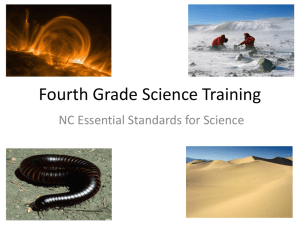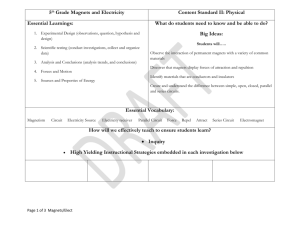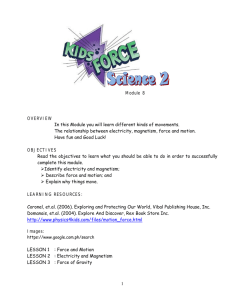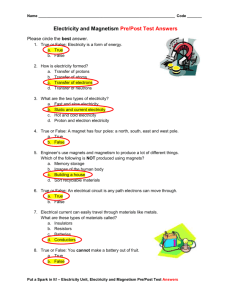Magnetism and Electricity
advertisement
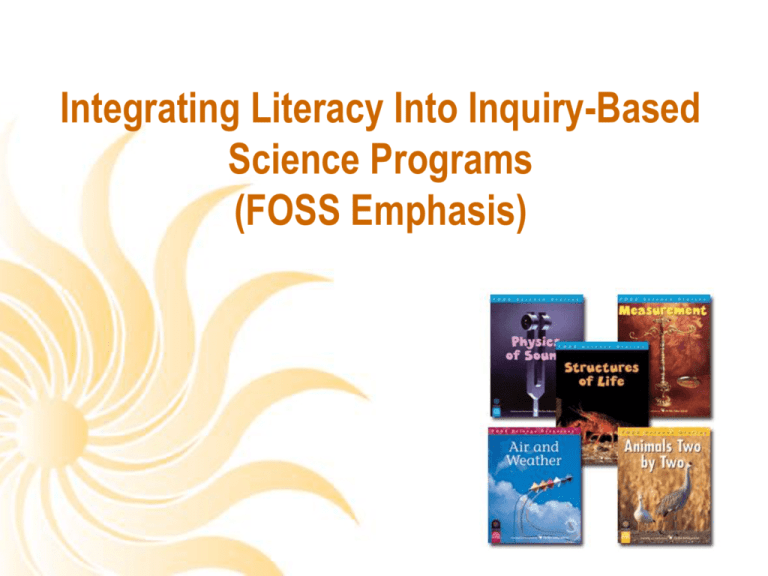
Integrating Literacy Into Inquiry-Based Science Programs (FOSS Emphasis) A Quick Share Jan Lanting FOSS Consultant 17 years in the classroom 4 years as District Science Coordinator lantingj@thompson.k12.co.us My Goals for You See how the Learning Cycle E model is woven into FOSS lessons/investigations Understand how literacy strategies support FOSS investigations Strategies for observing and evaluating science lessons in the elementary classroom Thought Swap Why integrate science and literacy in your classroom? Why integrate science and literacy? Reading and writing best reside in a content area Reading and writing are authentic to inquiry science Congested curriculum: finding time in the day for science Evidence of mutual benefit Proven benefits for English as A Second Language Learners What’s the Best Way to Learn About FOSS? Experience it! Life Earth, Physical, Scientific Reasoning and Technology NSF Funded and research-based Developmentally appropriate FOSS Special Education Multi-sensory Hands-on activities Cooperatively grouped Inquiry Essential Features of Inquiry: Learning Cycle E’s Engage Explore Explain Extend/Elaborate Evaluate Engage Piques their curiosity Determines students’ prior knowledge Stimulates their thinking A Signature Activity Magnetism and Electricity Investigation 1: The Force Describe the Object Things That Stick Focus Question: What can a magnet stick to around your seat? Literacy Strategies KWL/ KWLH Kit Inventory Interactive Word Wall Kit Inventory Basics From Dr. Olga Amaral Unpack the kit (literally), identify an object Place a word card on the wall for the object Add the kit object in a Ziploc baggie next to the word card Do this for each item in the kit Take the object down when you need it More How To’s Predicting Pull out one item at a time. Students predict how the item might be used. Classifying Items are distributed. Items are grouped by students into categories. Usage Properties Kit Inventory Process Questions The teacher asks the following questions: What is it? Teacher or student look at an object from the kit. What is it used for? Where have you seen this before? Why is it in our science kit? What does it feel, look, smell like? Your Interactive Science Word Wall Select words from each module that address the big ideas. Use the word bank to guide you. Discuss the words with your students. Write the words on tag board, strips of paper large enough to see from the other side of the room. Display on the word wall. Add picture or object in baggie next to word. leaf Why Interactive Word Walls? Facilitates notebook entries Students have input Includes scientific vocabulary Includes kit vocabulary leaves water Word Wall-ets fish worm snail isopod Word Wall-ets from Kellie Lauth and Tracy Tellinger, Adams 12 Use colored file folders for different subject areas. Open the file folder. This is the student’s individual word wall. Use labels or strips of paper for words. Find pictures or draw pictures that show the meaning of the term. Explore Provide hands-on, concrete experiences to formally construct a concept, process or skill Formulate a hypothesis, make a prediction Test hypothesis and gather data Notebook Components Focus questions/Problem/Purpose Prediction Planning Data Collection/Observations Claims & Evidence Conclusion (line of learning) Reflections ( I wonder…. Questions?) Science Story Explains how magnets were discovered and named FOSS: Science Stories Magnetism and Electricity Genre: Folk Tale • Stories passed down orally from generation to generation • Early cultures made up stories to explain natural phenomena • Often had animals in the stories Attract and Repel Standard: Develop an understanding of the position and motion of objects Develop an understanding of magnetism Assessment: Worksheet question Shared Reading “Magnificent Magnetic Models” FOSS: Science Stories Magnetism and Electricity “Magnus” vs. “Magnificent Magnetic Models” Standard: Student will identify similarities and differences in two reading selections. Assessments: T-Chart, Venn diagram Teacher led discussion Magnus How Magnets Interact Vocabulary/Word Bank force magnet magnetism attract repel Connections Kit Inventories Interactive Science Word Walls Vocabulary Development Your Interactive Science Word Wall Select words from each module that address the big ideas. Use the word bank to guide you. Discuss the words with your students. Write the words on tagboard, strips of paper large enough to see from the other side of the room. Display on the word wall. Add picture or object in baggie next to word. leaf Why Interactive Word Walls? Facilitates notebook entries Students have input Includes scientific vocabulary Includes kit vocabulary leaves water Kit Inventory Basics From Dr. Olga Amaral Unpack the kit (literally), identify an object Place a word card on the wall for the object Add the kit object in a ziplock baggie next to the word card Do this for each item in the kit Take the object down when you need it Kit Inventory Process Questions The teacher asks the following questions: What is it? Teacher or student look at an object from the kit. What is it used for? Where have you seen this before? Why is it in our science kit? What does it feel, look, smell like? More How To’s Predicting Pull out one item at a time. Students predict how the item might be used. Classifying Items are distributed. Items are grouped by students into categories. Use Properties Word Wall-ets fish worm snail isopod Word Wall-ets from Kellie Lauth and Tracy Tellinger, Adams 12 Use colored file folders for different subject areas Open the file folder. This is the student’s individual word wall. Use labels or strips of paper for words. Find pictures or draw pictures that show the meaning of the term. Content/Inquiry •Magnets stick to iron •Two magnets can attract and repel. •A force is a push or a pull. During a FOSS Investigation What was the role of the student? What was the role of the teacher? How did the teacher interact with the students? What was the source of the information the students were learning? What thought processes/scientific problem solving skills were the students using? Essential Features of Inquiry: Learning Cycle E’s Engage - Pique students’ curiosity, determines students’ prior knowledge, invites students to express what they think and ask questions. Explore - Student or teacher designed experiences that enable student to test questions and ides related to BIG IDEAS, encourages student-to-student interactions. Explain – Direct teaching of concepts through discussion, and vocabulary lessons. Students read for information. Students use common experiences and data to develop explanations. Students express their learning in a variety of ways. Extend/Elaborate - Students establish connections between new and former experiences. Further experiments to support learning may be provided. Evaluate- Students apply what they have learned in new situations, Investigation 1, Part 1 Engagement: Describe the Object Game Explore: Things That Stick Explore: Test Objects Explore: Iron Detectors Explore: Magnetic Interactions Explain: Attract and Repel, Force Elaborate: Science Stories, Math Problem of the Week, FOSSweb: Kitchen Magnets Evaluate: Teacher Observation, Assessment Chart 1 Investigating More Magnetic Properties How do magnets interact with other objects? Does an iron object have to touch a magnet to become a temporary magnet? Does magnetic force go through all materials? Investigation 2: Making Connections • Students find ways to make simple circuits Investigation 3: •Students build series and parallel circuits Investigation 4: Current Attractions Building an electromagnet Investigation 5: Click It Building the Telegraph Break •Register for prizes •Look at books •Ask Questions Integrating Literacy Strategies Into Your Foss Kit Interactive Editing “Magnets” Delta Science Reader Electricity and Magnetism Anticipation Guides “What is a Compass” FOSS: Science Stories Magnetism and Electricity “Make a Compass” • Use Nonfiction Checklist • Discuss Table of Contents • Explain function of the glossary Standards: Students will identify the resource appropriate for a specific purpose, and use that resource to locate information. Students will identify and apply knowledge of the text structure and organizational elements to analyze nonfiction or informational text. Assessment: FOSS: Science Stories • Nonfiction Checklist Magnetism and Electricity • Discussion Main Idea “Renewable Resources” Standard: Students will identify the main idea and supporting details in what they have read. Assessment: Main idea graphic worksheet Delta Science Reader Electricity and Magnetism Stop and Jot “Ben Franklin” FOSS: Science Stories Magnetism and Electricity Additional Strategies Frayer Model I Wonder I See Journal Prompts • Science Assessments Formative Assessments • Teacher Observation • Anecdotal Records • File Folder • Rubric – Student Response Sheet • Student Notebook • Summative Assessments • End of Unit Test • Performance Assessment Quote "Tell me and I forget. Teach me and I remember. Involve me and I learn." Benjamin Franklin Focus question: What kind of materials do magnets stick to? Formulate a Hypothesis: Example: If all metal objects stick to a magnet, then we can sort the objects into two groups, metal/non-metal, and all objects in the metal group should stick to the magnet. Predict and gather data Literacy Strategies I’m Curious – Example: “What Makes You Curious About…” Quick Write – Example: Giant Magnet Science Story Explains how magnets were discovered and named in a folk talk genre. FOSS: Science Stories Magnetism and Electricity Literacy Strategies Science Story Word Splash Stop and Jot Paired Reading Questioning Cubes Attract and Repel Focus Question: What happens when two or more magnets interact? Explain Students use common experiences and data to develop and discuss explanations Teacher clarifies student concepts, corrects misconceptions and introduces scientific terminology Connect student’s explanations to experiences from engage and explore phases Provide reading and writing opportunities to reinforce concepts. Vocabulary / Word Bank force magnet magnetism attract repel Vocabulary Strategies Frayer Model Word Web Foldables 3 Column Vocabulary Glossary Index Glossary: 3 Column Vocabulary Word Magnet Picture Example Bar Horseshoe Refrigerator Donut Content / Inquiry Magnets stick to iron Two magnets can attract and repel. A force is a push or a pull. Magnetism is a force Extend / Elaborate Correct any remaining misconceptions Expand student understanding of the concept in a broader context beyond the previous explorations May provide further investigations in new situations to support learning Shared Reading “How Magnets Interact” FOSS: Science Stories Magnetism and Electricity “Magnus” vs. “How Magnets Interact” Student will identify similarities and differences between two reading selections. Assessments: T-Chart, Venn diagram Teacher-led discussion Magnus How Magnets Interact Main Idea “Electromagnets” Assessment: Main idea graphic worksheet Delta Science Content Reader Electricity and Magnetism “Make a Compass” Nonfiction Checklist FOSS: Delta Science Content Readers Magnetism and Electricity Evaluate Teachers use a variety of formal and in-formal procedures to assess conceptual understanding and progress towards learning objectives Students apply what they have learned in new situations to test their own understanding and skills Interactive Editing “Magnets” Delta Science Reader Electricity and Magnetism Anticipation Guides “What is a Compass” FOSS: Science Stories Magnetism and Electricity Discourse Circle Discourse Statement: Renewable sources of energy are best for making electricity. Delta Science Content Reader Seeds of Science 2008 Electricity and Magnetism Additional Strategies I Wonder I See Quote “Tell me and I forget. Teach me and I remember. Involve me and I learn.” Benjamin Franklin

